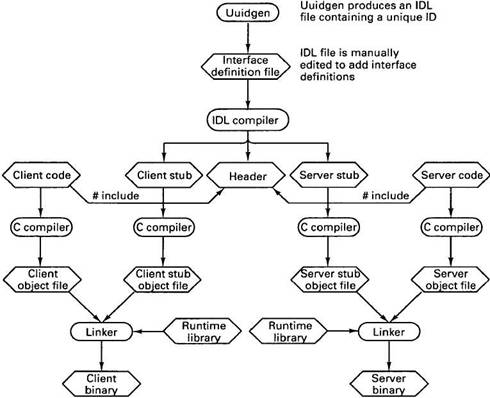Книга: Distributed operating systems
10.3.2. Writing a Client and a Server
10.3.2. Writing a Client and a Server
The DCE RPC system consists of a number of components, including languages, libraries, daemons and utility programs, among others. Together these make it possible to write clients and servers. In this section we will describe the pieces and how they fit together. The entire process of writing and using an RPC client and server is summarized in Fig. 10-13.

Fig. 10-13. The steps in writing a client and a server.
In a client/server system, the glue that holds everything together is the interface definition. This is effectively a contract between the server and its clients, specifying the services that the server is offering to the clients.
The concrete representation of this contract is a file, the interface definition file, which lists all the procedures that the server allows its clients to invoke remotely. Each procedure has a list of the names and types of its parameters and of its result. Ideally, the interface definition should also contain a formal definition of what the procedures do, but such a definition is beyond the current state of the art, so the interface definition just defines the syntax of the calls, not their semantics. At best the writer can add a few comments describing what he hopes the procedures will do.
Interface definitions are written in a language brilliantly named the Interface Definition Language, or IDL. It permits procedure declarations in a form closely resembling function prototypes in ANSI C. IDL files can also contain type definitions, constant declarations, and other information needed to correctly marshal parameters and unmarshal results.
A crucial element in every IDL file is an identifier that uniquely identifies the interface. The client sends this identifier in the first RPC message and the server verifies that it is correct. In this way, if a client inadvertently tries to bind to the wrong server, or even to an older version of the right server, the server will detect the error and the binding will not take place.
Interface definitions and unique identifiers are closely related in DCE. As illustrated in Fig. 10-13, the first step in writing a client/server application is usually calling the uuidgen program, asking it to generate a prototype IDL file containing an interface identifier guaranteed never to be used again in any interface generated anywhere by uuidgen. Uniqueness is ensured by encoding in it the location and time of creation. It consists of a 128-bit binary number represented in the IDL file as an ASCII string in hexadecimal.
The next step is editing the IDL file, filling in the names of the remote procedures and their parameters. It is worth noting that RPC is not totally transparent — for example, the client and server cannot share global variables — but the IDL rules make it impossible to express constructs that are not supported.
When the IDL file is complete, the IDL compiler is called to process it. The output of the IDL compiler consists of three files:
1. A header file (e.g., interface.h, in C terms).
2. The client stub.
3. The server stub.
The header file contains the unique identifier, type definitions, constant definitions, and function prototypes. It should be included (using #include) in both the client and server code.
The client stub contains the actual procedures that the client program will call. These procedures are responsible for collecting and packing the parameters into the outgoing message and then calling the runtime system to send it. The client stub also handles unpacking the reply and returning values to the client.
The server stub contains the procedures called by the runtime system on the server machine when an incoming message arrives. These, in turn, call the actual server procedures that do the work.
The next step is for the application writer to write the client and server code. Both of these are then compiled, as are the two stub procedures. The resulting client code and client stub object files are then linked with the runtime library to produce the executable binary for the client. Similarly, the server code and server stub are compiled and linked to produce the server's binary. At runtime, the client and server are started to make the application run.
- 2.4.6. Problem Areas
- 7.2.1. Capabilities
- 10.3. REMOTE PROCEDURE CALL
- 10.3.1. Goals of DCE RPC
- 10.3.4. Performing an RPC
- 9.7.2.1 Interactive mode
- Тестирование Web-сервиса XML с помощью WebDev.WebServer.exe
- InterBase Super Server для Windows
- Каталог BIN в SuperServer
- Минимальный состав сервера InterBase SuperServer
- InterBase Classic Server под Linux
- Каталог BIN в InterBase Classic Server для Linux




